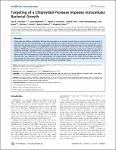Targeting of a chlamydial protease impedes intracellular bacterial growth.
Christian, Jan G.
Heymann, Julia
Paschen, Stefan A.
Vier, Juliane
Schauenburg, Linda
Rupp, Jan
Meyer, Thomas F.
Häcker, Georg
Heuer, Dagmar
Chlamydiae are obligate intracellular bacteria that propagate in a cytosolic vacuole. Recent work has shown that growth of Chlamydia induces the fragmentation of the Golgi apparatus (GA) into ministacks, which facilitates the acquisition of host lipids into the growing inclusion. GA fragmentation results from infection-associated cleavage of the integral GA protein, golgin-84. Golgin-84-cleavage, GA fragmentation and growth of Chlamydia trachomatis can be blocked by the peptide inhibitor WEHD-fmk. Here we identify the bacterial protease chlamydial protease-like activity factor (CPAF) as the factor mediating cleavage of golgin-84 and as the target of WEHD-fmk-inhibition. WEHD-fmk blocked cleavage of golgin-84 as well as cleavage of known CPAF targets during infection with C. trachomatis and C. pneumoniae. The same effect was seen when active CPAF was expressed in non-infected cells and in a cell-free system. Ectopic expression of active CPAF in non-infected cells was sufficient for GA fragmentation. GA fragmentation required the small GTPases Rab6 and Rab11 downstream of CPAF-activity. These results define CPAF as the first protein that is essential for replication of Chlamydia. We suggest that this role makes CPAF a potential anti-infective therapeutic target.
No license information

